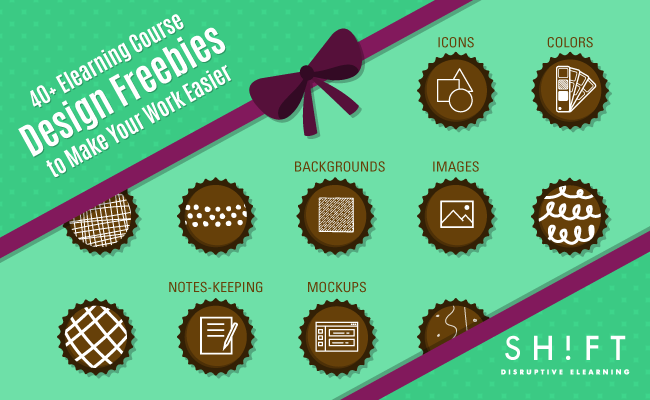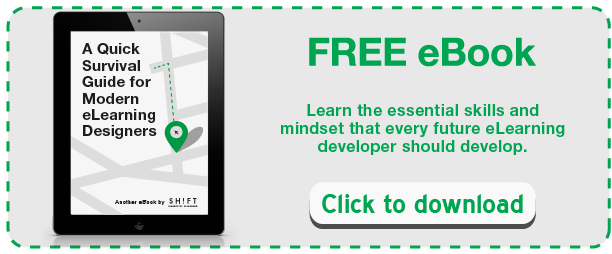There are few things more frustrating than finding an awesome, free online design tool then not being able to find it again. As an eLearning course designer you likely have experienced this problem along with the increasing demands put on you to not only write a course but also to design graphic elements. Because of this, it is more important than ever to have your arsenal of design tools organized and ready so you can work efficiently without working harder.
Over the years we have bump into different tools, sites and free resources that have been very helpful to us, so we’ve collected them and we are sharing them with you!
Icon Sets:
Icon sets, matching predesigned characters and symbols, help your courses look professional with a cohesive theme without you, personally, having to design every single element that goes on the screen. Try these quick and free resources to help you build an icon set library:
- Geek Pack: Mix and match these geek themed icons to create completely different illustrations.
- 48 icon-pack: Simple, graphic icons to create visual interest in text.
- Flat Graphics: Spruce up your course with popular icons drawn in the trendy and colorful flat style.
- Hand-drawn icons: 130 hand-drawn interface icons.
- Pie chart icon set: Move the pieces around on these pie chart graphics for a more accurate representation of your data.
- Education icons: Simple, line graphics to go with every school subject.
- Office icons: A small collection of icons useful for business courses.
- Finally, check out these 50 sites to find useful free icons.
Color Schemes and Color Palette Resources:
Deciding on a palette that perfectly matches your needs can be a frustrating process. To make this easier, use these sites and resources and create color combinations that rock:
- Adobe Kuler: Create an entirely new color scheme or search for others based on your preferences and keywords.
- Degraeve and Pictaculous: Generate a color theme based on any photo you choose. These are excellent for identifying commonly used colors and matching themes to images you want to use.
- Colord, CodeCondo and Design Seeds: Browse through huge lots of color codes then simply copy and paste to create your own palette. These sites work amazingly if what you just need is inspiration.
Backgrounds, Texture, and Pattern Sets:
Creating visually attractive designs can make the difference between a successful and engaging eLearning course, and one that puts learners to sleep. Mix and match textures, background and patterns wisely with your other graphics for maximum visual appeal. Try these resources for backgrounds to fit every subject matter:
- Free Textures
- Chalk Drawing
- Blurry backgrounds
- Abstract
- Blurred
- 100-pack pattern backgrounds
- Free Patterns
- Wood Textures
- Wood Backgrounds
Mockups:
Mockups help you get a presentation together quickly that you can use to promote your course in the company or to present to clients and other team members. Add your own taglines and get creative to customize your mockups!
- Hero Mockup: Separate objects and layers let you fully customize these hero images.
- Ipad Mockup: Create sleek, Ipad style mockups.
- Cool mockups: Get free PSD mockups when you like and tweet the page.
- Creativity Bundle: Premium products bundled for free!
- Computer and Desk Essentials: Insert your own artwork and you’re done!
Image Assets:
Stock photography allows you to choose from a large selection of free, high quality graphics without the hassle of creating your own images or the expense of original photography. The only problem is, is that stock photos can seem pretty boring, but the good news is that sites like Unsplash, Pexels and Splashbase offer non-stock photos for free on a regular basis. Check out these links for examples of some of the great photography they offer:
Unsplash releases 10 new photos every 10 days under the creative commons public domain license. Pexels releases daily 5 new high-quality photos.
An important note: Always read the licensing terms of the image you want to use to determine if you can use it personally or professionally and if you need to give credit.
Other creative places you might want to bookmark:
- Picjumbo: Premium downloads for free.
- Stokpic: Get 10 new free premium images every two weeks!
- Alubumarium: Find and share beautiful imagery.
- Gratisography: New, high-resolution images added weekly.
- DeathtotheStockPhoto: Fresh photos every month.
- Madeleine: A free high-resolution image every day
- Dealjumbo: free image pack.
- Creativetail: cutout images.
- MadeinMoments: Sign up for 7 new photos weekly.
- NaturePhotos: More images from dealjumbo.
- FreeGoodiesforDesigners: Tropical images.
Last but not least:
Keep your ideas organized with Evernote, a collaboration and writing tool that will store everything from half-baked ideas to detailed research and short lists. Take notes, outline projects and generally collect your thoughts with this app that allows you to sync across every device you use.
Use Evernote now to save this blog post and get your eLearning designer’s toolkit ready to work!









